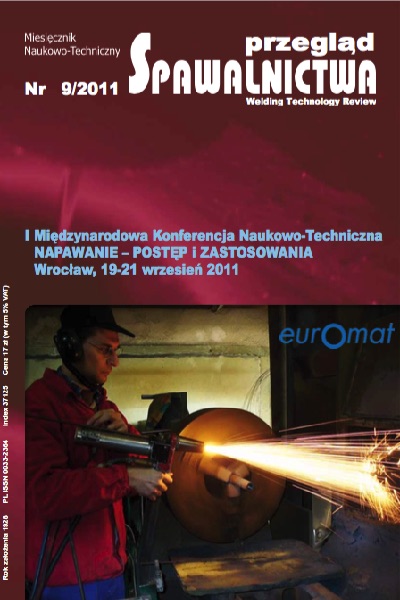Napawanie krawędzi przedmiotów metodami TIG i PTA
Main Article Content
Abstract
W artykule przedstawiono badania zautomatyzowanego procesu napawania produkcyjnego i naprawczego krawędzi przedmiotów metodami TIG i PTA z materiałem dodatkowym w postaci zimnego drutu. Określono wpływ sposobu podawania drutu położenia jego końcówki względem jeziorka ciekłego metalu na stabilność procesu oraz kształt i jakość uzyskiwanych napoin. Zwrócono uwagę na zmienność warunków przebiegu procesu napawania przy zmianie stopnia koncentracji źródła ciepła. Wyznaczone pole parametrów optymalnych obu metod pozwoliło na opracowanie technologii napawania napoin o gładkim i równym licu na krawędziach przedmiotów oraz umożliwiło precyzyjne sterowanie kształtem i wymiarami geometrycznymi napoin.
The surfacing of the items edges by TIG and PTA methods
Abstract
The paper presents a test of automated manufacturing and repair surfacing by welding process of items edges. TIG and PTA with additional material in the form of a cold wire is used in the test. The influence of the method of wire supply and the wire tip position above the liquid metal on the process stability and also the shape and quality of padding welds are investigated. The variation of the process of surfacing in the change of concentration of the heat source is obtained. The designated field of optimal parameters of both methods led to the technology development of surfacing by welding which allows to produce high quality welds with a smooth and equal face on the edges of items and allowed to precise control of geometric shape and dimensions of padding welds.
Downloads
Article Details
Creative Commons CC BY 4.0 https://creativecommons.org/licenses/by/4.0/
Welding Technology Review (WTR) articles are published open access under a CC BY licence (Creative Commons Attribution 4.0 International licence). The CC BY licence is the most open licence available and considered the industry 'gold standard' for open access; it is also preferred by many funders. This licence allows readers to copy and redistribute the material in any medium or format, and to alter, transform, or build upon the material, including for commercial use, providing the original author is credited.
References
Zheng S., Dayou P., Min K.: Precision Welding for Edge Buildup and Rapid Prototyping, SIMTech Technical Report PT 00/001/JT, s. 1-7.
Cheng F.T., Lo K.H., Mana H.C.: NiTi cladding on stainless steel by TIG surfacing process Part II. Corrosion behavior, Surface & Coatings Technology 172, 2003, s. 316-321.
Song J., Deng Q., Chen Ch., Hu D., Li Y.. Rebuilding of metal components with laser cladding forming, Applied Surface Science 252, 2006.
Shacklock A., Hong L., Sheng H., Wang Jie Yu J.: Intelligent Robotics GTAW System for 3D Welding, SIMTech Technical Report AT 01/013/AMP, s. 1-10.
Kirkhope K.J., Bell R., Caron L., Basu R.I., Ma K.T.: Weld detail fatigue life improvement techniques. Part 2: application to ship structures, Marine Structures, vol. 12, issues 7-8, August 1999, s. 477-496.
Gandy D.W., Frederick G., Stover J.T., Viswanathan R.: Overview of Hot Section Component Repair Methods. EPRI RRAC Charlotte, North Carolina.
F.T. Cheng, K.H. Lo, H.C. Mana: NiTi cladding on stainless
steel by TIG surfacing process Part I. Cavitation erosion behavior, Surface & Coatings Technology 172 2003, s. 308- 315.
Okazaki M., Ohetera I., Harada Y.: Damage Repair in CMSX- 4 Alloy without Fatigue Life Reduction Penalty. Metallurgical and Materials Transactions A. 2004, vol. 35. no. 2. s. 535-542.
Zheng Sun, Min Kuo, Dayou: Twin wire Gas Tungsten Arc Cladding, SIMTech Technical Report PT 00/004/JT, s. 1-8.
Bolmsjo G.: Programming robot welding system using advanced simulation tools, Division of Robotics, Dept. of Mechanical Engineering, Lund University, s. 1-8.
Shu-Yi T., Ming-Der J., Wang J.T., Chun-Sen W.: A robots design in hardfacing using a plasma transfer arc, The International Journal of Advanced Manufacturing Technology, 2006, nr 9-10 vol. 27, s. 889-896.
